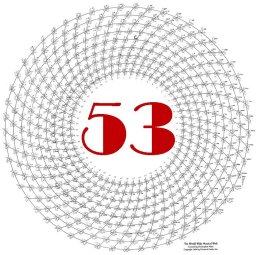Next Page: 16/2 – Musical Spirituality
Whole-Tone and Other Scales
There are other atonal 20th century effects that can be employed in 53-eq, with reservations. Debussy used the six-note whole-tone scale to create entirely new soundscapes. But again, in the prime-number based 53-eq system, you can’t divide the octave into six truly equal parts (12/6 = 2; 53/6 = 8.83333…). You can imitate the sound and feel of a whole-tone scale, but you can’t use the hexatonic scale to circle around and back to where you started unless you create a scale of unequally-spaced whole tones. I consider this to have an amazing side-effect, however. Listen to the music in Figure 15-6 below. Debussy often used to employ whole-tone scales and the augmented triads they create for shorter passages within a tonal fabric. In this context, whole-tone runs were used as a technique for tonal modulation. For my simple example, I play a 53-eq approximation of augmented triads (a stack of three just thirds going straight up the lattice) above a “whole-tone” scale ascending by 10/9 major seconds in 53-eq, then land on a very different C! In fact, the B#6 where I arrive plays the same pitch as the note B1. This “whole-tone” run takes you into some extreme accidentals, so I use enharmonic notation to help make the journey more readable, with the actual notation on the left and the enharmonic notation on the right within each bracket. My pseudo whole-tone lick does the opposite of emphasizing symmetry; it emphasizes the asymmetrical nature of 53-eq where you land in a completely different harmonic sector of the musical galaxy instead of returning to C! You can also create a 9/8-based “whole-tone” scale in 53-eq, by having as the root notes C – D -E -F# – G# – A# – B#, straight along the Pythagorean spine. In that case, you would end up a Pythagorean comma C’ at the end, which would bring you in much closer to where you started than you will with the example below. Notice, too, that the augmented triads all consist of different notes from one another.Not one note anywhere is repeated this “whole-note” run. For example, from G2# in the first chord, the next G# you find is actually a G3# two chords later, then a G4# two chords after that. Here is the rather radical 10/9 “whole-tone” scale for those of you who want to take a wilder ride. If you think you’ve gone up six whole tones by the end and landed back on C, keep listening and you will hear how far off you are. After a brief pause, I return to the first augmented triad of this “whole-tone” progression, and it is a half-step away from the C we started at!
Figure 15-6 (53-eq whole tones going up with aug triads)
If you would like to learn more about the ancient and contemporary tunings worldwide, you can buy the entire book, The Grand Unified Theory of Music, in pdf form for $25 with hundreds of embedded musical examples of scales and chords from all over the world HERE.
A free introduction to what The Grand Unified Theory of Music offers is on this website and includes both text and a few musical examples from each webpage. If you would like to learn more about this chapter and the full contents of this entire e-book, you can buy The Grand Unified Theory of Music for $25, with hundreds of embedded musical examples of scales and chords from all over the world — and ideas for how to set up your computer system —
HERE.
You’ll get a personalized password you can use to see the entire e-book. Inside the full book, you will also get a link to the complete pdf file of this e-book, which you can read on your Kindle or similar device. The links to the hundreds of mp3 sound files – the same ones you can hear on the website — will also be included. This is “Version 1.0” of The Grand Unified Theory of Music. Because it is an e-book, additions, corrections and improvements in the sound may be added at any time. The Grand Unified Theory of Music is Copyright © 2018 by Christopher Mohr. All rights reserved.
One person per password. Sharing this password with others is a violation of copyright. Do not allow others to use your password or link to the pdf file!

